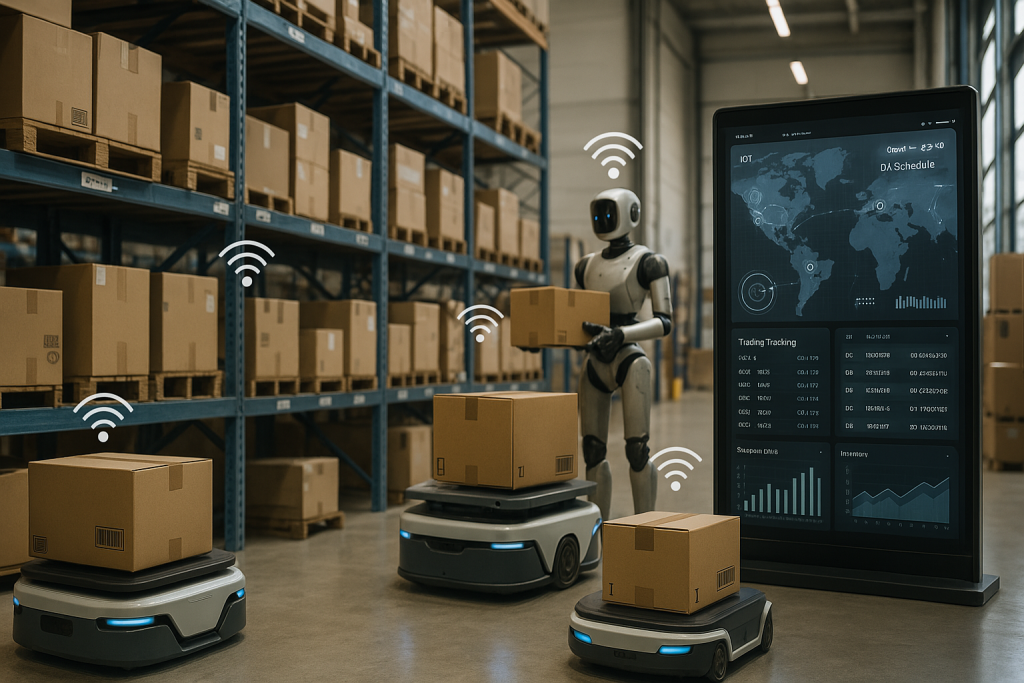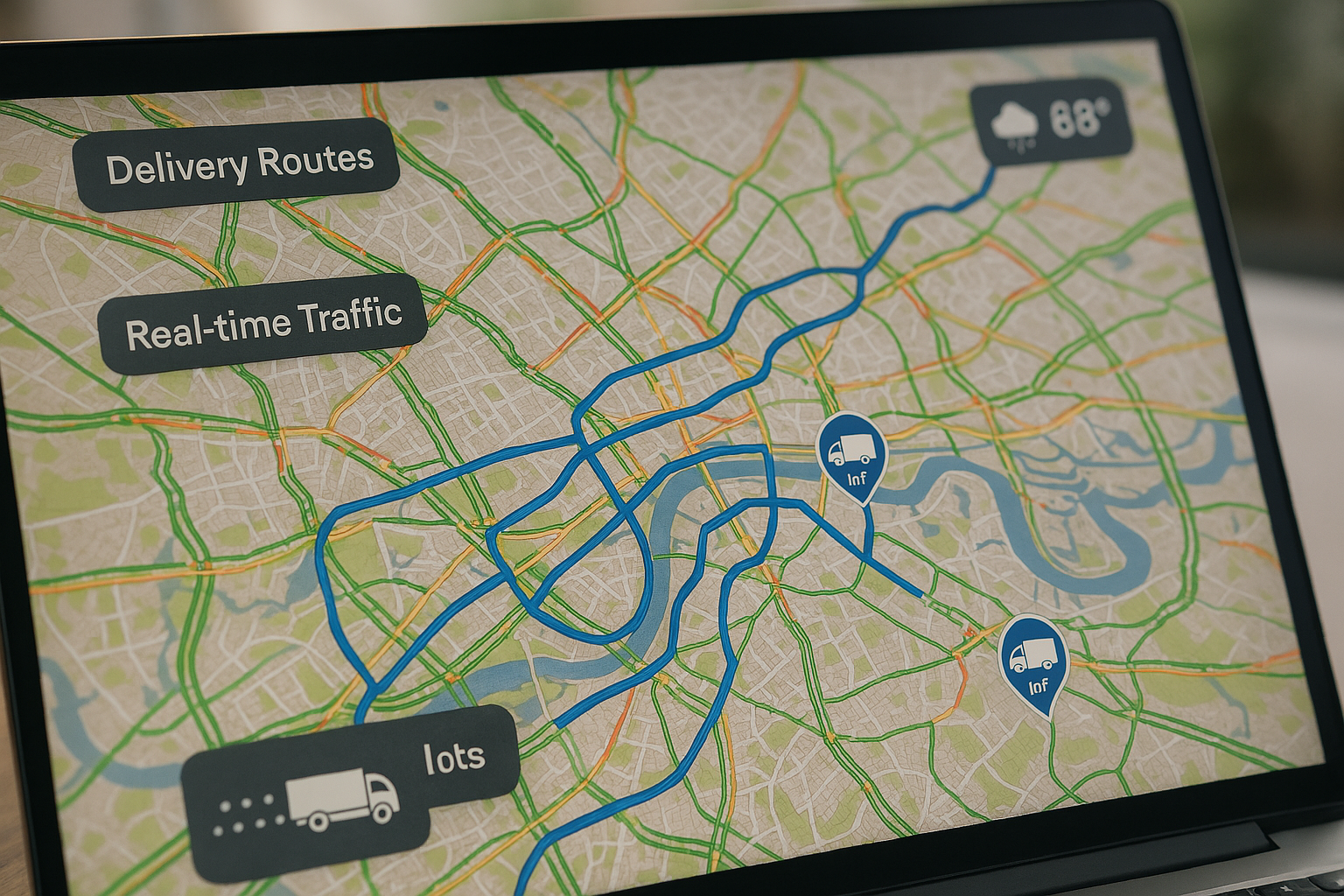The Internet of Things (IoT) is making waves across various industries, and transportation and logistics are no exceptions. By integrating IoT technologies, businesses can unlock significant improvements in efficiency, cost savings, and customer satisfaction. This blog explores the many benefits of IoT in these sectors, from real-time tracking to predictive maintenance, and how these advancements are transforming the way goods move around the world.
Table of contents
- What is IoT in Transportation and Logistics?
- Key Benefits of IoT in Transportation and Logistics
- Challenges and Considerations
- Future Trends in IoT for Transportation and Logistics
- 1. Integration of Artificial Intelligence (AI) and Machine Learning
- 2. Enhanced Data Security with Blockchain
- 3. 5G Networks Enabling Faster IoT Communication
- 4. Autonomous Vehicles and Drones
- 5. Smart Warehousing and Inventory Management
- 6. Sustainability and Green Logistics
- 7. IoT-Enabled Smart Ports and Smart Cities
- Conclusion
- Frequently Asked Questions (FAQs) about IoT in Transportation and Logistics
- 1. What is IoT in transportation and logistics?
- 2. How does IoT improve route optimization?
- 3. What are the benefits of using real-time tracking in transportation?
- 4. How does IoT contribute to predictive maintenance in the logistics industry?
- 5. What role does IoT play in improving safety and security?
- 6. How does IoT help in enhancing supply chain visibility?
- 7. Can IoT reduce operational costs in logistics?
- 8. What challenges do businesses face when implementing IoT in logistics?
- 9. How does IoT improve customer satisfaction in logistics?
- 10. What is the future of IoT in transportation and logistics?
What is IoT in Transportation and Logistics?
At its core, IoT refers to the network of physical devices embedded with sensors, software, and other technologies that connect to the internet, allowing them to collect and exchange data. In the context of transportation and logistics, IoT devices range from GPS trackers to temperature sensors, RFID tags, and smart vehicles.
By connecting various elements of the supply chain — such as vehicles, warehouses, cargo, and infrastructure — IoT enables businesses to access real-time data, optimize operations, and improve decision-making.

Key Benefits of IoT in Transportation and Logistics
A. Real-Time Tracking and Monitoring
One of the most impactful benefits of IoT in transportation is real-time tracking. With IoT devices installed on vehicles or shipments, businesses can monitor the location and status of goods in transit at any given time. This visibility helps companies offer better customer service by providing accurate delivery estimates and status updates.
Moreover, real-time tracking reduces the chances of theft or loss, as goods can be tracked continuously throughout the entire supply chain. This level of transparency not only improves operational efficiency but also boosts customer trust and satisfaction.
Example: Shipping companies use GPS-enabled IoT solutions to track the movement of containers, ensuring timely arrivals and reducing delays.
B. Improved Route Optimization
With IoT devices collecting and analyzing data from various sources, businesses can optimize delivery routes to minimize fuel consumption, reduce travel time, and cut transportation costs. IoT solutions can factor in variables such as traffic, weather, road conditions, and fuel consumption to suggest the most efficient routes.
By implementing these insights, companies can enhance productivity, improve driver safety, and even reduce their carbon footprint.
Example: Delivery companies use IoT-powered route optimization software to reroute drivers in real time based on traffic conditions, resulting in faster deliveries and lower operational costs.
C. Predictive Maintenance
Another standout benefit of IoT in transportation is predictive maintenance. By equipping vehicles with IoT sensors, businesses can collect data on engine performance, tire pressure, fuel consumption, and other critical metrics. This data can be used to predict when maintenance is needed, preventing unexpected breakdowns and costly repairs.
Predictive maintenance not only reduces downtime but also extends the lifespan of vehicles, making it a cost-effective solution for fleet management.
Example: A logistics company uses IoT sensors to monitor the condition of its fleet, scheduling maintenance only when necessary and avoiding costly emergency repairs.
D. Enhanced Security and Safety
IoT plays a crucial role in improving security and safety within transportation and logistics. IoT devices such as cameras, motion sensors, and alarms help secure goods during transit, preventing theft and tampering. Additionally, IoT-enabled monitoring systems can track environmental factors like temperature and humidity, ensuring that sensitive goods like pharmaceuticals and food items are stored and transported under the right conditions.
For drivers, IoT also enhances safety by providing real-time alerts about road hazards, vehicle malfunctions, or even driver fatigue, reducing accidents and ensuring compliance with safety standards.
Example: A logistics company equips its delivery trucks with IoT-enabled cameras and motion sensors to prevent cargo theft and improve vehicle safety.
E. Supply Chain Visibility and Efficiency
IoT offers unprecedented visibility into the entire supply chain, allowing businesses to monitor every step of the process, from warehousing to last-mile delivery. By collecting and analyzing data at each stage, companies can identify bottlenecks, optimize workflows, and make informed decisions to improve overall efficiency.
With better visibility, businesses can respond more quickly to disruptions and customer demands, reducing lead times and enhancing overall service delivery.
Example: Companies in the retail industry use IoT to track products from the manufacturer to the end consumer, ensuring timely deliveries and improving inventory management.
F. Reduced Operational Costs
Implementing IoT technology leads to significant cost savings by automating processes, reducing human error, and optimizing resource use. With real-time data, businesses can make more informed decisions on inventory management, fleet scheduling, and resource allocation.
By streamlining operations, companies can reduce operational overheads and achieve higher profit margins. Additionally, the data provided by IoT devices enables companies to track performance metrics and measure the return on investment (ROI) for their IoT solutions.
Example: An international logistics provider reduces fuel consumption and labor costs by using IoT to optimize vehicle routes and automate warehouse processes.
Challenges and Considerations
While the benefits of IoT are clear, businesses must consider several challenges when implementing these technologies. The primary hurdle is the initial investment in IoT infrastructure, which can be costly, especially for small and medium-sized enterprises. Moreover, data privacy and cybersecurity are important concerns, as IoT devices generate large amounts of sensitive data that must be protected.
Another challenge is the integration of IoT with existing legacy systems. Companies need to ensure that their IoT solutions are compatible with current software and processes to maximize efficiency.

Future Trends in IoT for Transportation and Logistics
As technology continues to evolve at a rapid pace, the potential applications of IoT in transportation and logistics are expected to expand significantly. The combination of IoT with other cutting-edge technologies is creating new possibilities for smarter, more efficient, and automated systems within the industry. Emerging technologies such as Artificial Intelligence (AI), machine learning, blockchain, and 5G networks are enhancing the capabilities of IoT, enabling businesses to streamline operations and unlock new efficiencies.
1. Integration of Artificial Intelligence (AI) and Machine Learning
Artificial Intelligence (AI) and machine learning (ML) are playing an increasingly important role in enhancing IoT in transportation and logistics. AI algorithms can analyze vast amounts of data collected by IoT devices, enabling predictive analytics that helps optimize operations. For instance, AI can be used to predict traffic patterns, forecast demand, and optimize delivery schedules, reducing delays and improving service levels.
Machine learning models, powered by IoT data, allow systems to learn from past patterns and continuously improve their decision-making capabilities. For example, AI can help manage dynamic pricing for logistics services based on real-time demand and availability, making logistics operations more adaptive and efficient.
2. Enhanced Data Security with Blockchain
As the volume of data generated by IoT devices in transportation and logistics increases, the need for robust data security becomes even more critical. Blockchain technology is increasingly being integrated with IoT to address data security and transparency challenges. Blockchain can provide an immutable, decentralized record of transactions and data exchanges, ensuring the integrity and authenticity of information.
In logistics, blockchain can be used to track the provenance of goods and verify every step of the supply chain process, reducing fraud and ensuring the security of shipments. Additionally, the combination of IoT and blockchain allows for more secure and efficient contract management, streamlining processes such as payments, inventory control, and customs documentation.
3. 5G Networks Enabling Faster IoT Communication
The rollout of 5G networks is expected to significantly enhance the capabilities of IoT devices in transportation and logistics. With much higher bandwidth and lower latency, 5G will allow for faster, real-time communication between IoT devices. This will enable businesses to monitor assets, vehicles, and shipments with even greater precision and responsiveness.
For example, 5G connectivity will allow autonomous vehicles to communicate instantly with each other and with the central control systems, improving traffic management and safety. Additionally, the high-speed data transfer enabled by 5G will support more sophisticated IoT applications, such as remote diagnostics and real-time vehicle performance monitoring.
4. Autonomous Vehicles and Drones
The rise of autonomous vehicles and drones will further revolutionize the logistics industry, offering tremendous opportunities to streamline operations and reduce labor costs. Self-driving trucks, powered by IoT sensors and AI algorithms, are already being tested by companies like Tesla and Waymo for long-haul freight transportation. These vehicles promise to increase efficiency, reduce fuel consumption, and improve safety by eliminating human error.
In addition, drones are emerging as a solution for last-mile delivery. IoT-enabled drones can autonomously navigate and deliver packages, reducing delivery times, and costs, and improving customer satisfaction. As regulations evolve to accommodate the rise of drones, businesses can expect this technology to play a larger role in urban logistics, especially for small or time-sensitive deliveries.
5. Smart Warehousing and Inventory Management
The future of IoT in transportation and logistics will also see more advanced smart warehousing systems. IoT sensors, integrated with AI and robotics, will automate tasks such as inventory tracking, order picking, and packaging. Smart warehouses will be able to dynamically adjust operations based on real-time data, improving efficiency and reducing human intervention.
For instance, RFID and IoT sensors will provide real-time visibility into inventory levels, enabling businesses to optimize stock levels, reduce overstocking or understocking, and prevent goods from expiring. This level of automation and data visibility will lead to fewer errors, faster processing times, and reduced labor costs.
6. Sustainability and Green Logistics
Sustainability is becoming an increasingly important focus in logistics, and IoT is helping businesses move toward greener practices. By integrating IoT with real-time data on vehicle performance, fuel consumption, and emissions, businesses can monitor and optimize their environmental impact.
For example, IoT solutions can track the fuel efficiency of delivery trucks, helping fleet managers identify opportunities for optimization, such as selecting eco-friendly routes or maintaining vehicles more effectively. Additionally, IoT-enabled electric vehicles (EVs) and charging stations are becoming more prominent, helping to reduce the carbon footprint of transportation.
Moreover, businesses are using IoT to optimize packaging, reduce waste, and improve recycling efforts. By integrating sustainability metrics with IoT data, companies can improve their environmental performance while maintaining cost efficiency.
7. IoT-Enabled Smart Ports and Smart Cities
As global trade continues to expand, the logistics industry is looking to improve port operations through IoT-enabled smart ports. These ports use IoT devices to monitor cargo, track shipping containers, and streamline operations. This helps reduce congestion, optimize container movement, and enhance overall port productivity.
Similarly, smart city initiatives are becoming an essential part of urban logistics. IoT applications in smart cities can optimize transportation infrastructure, reduce congestion, and improve traffic management, which is crucial for the movement of goods within densely populated areas. IoT technologies can also be used to enhance last-mile delivery systems, particularly with the rise of urban delivery hubs and automated delivery systems.
Conclusion
The Internet of Things is transforming the transportation and logistics industries by providing real-time tracking, predictive maintenance, route optimization, and enhanced safety, among other benefits. These technologies not only improve operational efficiency but also help businesses reduce costs and improve customer satisfaction. While there are challenges in adopting IoT, the potential rewards make it a worthwhile investment for companies looking to stay competitive in an increasingly digital world.
As IoT continues to evolve, its role in transportation and logistics will only grow, providing new opportunities for businesses to innovate and improve their operations.
Are you ready to take advantage of IoT in your transportation and logistics operations? Explore IoT solutions that can streamline your supply chain and improve efficiency. Contact our team of experts to get started today!
Frequently Asked Questions (FAQs) about IoT in Transportation and Logistics
1. What is IoT in transportation and logistics?
IoT in transportation and logistics refers to the integration of smart devices and sensors that collect and exchange data in real-time. These devices are used to track shipments, optimize routes, monitor vehicle performance, and improve overall supply chain efficiency.
2. How does IoT improve route optimization?
IoT helps optimize routes by providing real-time data on traffic, weather, road conditions, and fuel consumption. This allows logistics companies to plan the most efficient routes, reducing travel time, fuel costs, and carbon emissions.
3. What are the benefits of using real-time tracking in transportation?
Real-time tracking provides visibility into the location and status of goods, enhancing customer satisfaction with accurate delivery updates. It also helps reduce theft, monitor delays, and manage the supply chain more effectively.
4. How does IoT contribute to predictive maintenance in the logistics industry?
IoT-enabled sensors in vehicles monitor the condition of key components like engines, tires, and fuel systems. By analyzing this data, companies can predict when maintenance is needed, preventing breakdowns, reducing downtime, and lowering repair costs.
5. What role does IoT play in improving safety and security?
IoT enhances safety and security by enabling surveillance and monitoring systems for cargo. It helps prevent theft and damage by tracking goods in transit. Additionally, IoT systems can alert drivers to potential hazards and vehicle issues, reducing accidents.
6. How does IoT help in enhancing supply chain visibility?
IoT offers full visibility into the supply chain by tracking every step of a product’s journey from manufacturing to delivery. This visibility allows businesses to address potential bottlenecks, monitor inventory in real-time, and improve overall operational efficiency.
7. Can IoT reduce operational costs in logistics?
Yes, IoT can reduce operational costs by automating processes, optimizing vehicle routes, improving inventory management, and reducing fuel consumption. By providing actionable data, IoT also minimizes human errors and unnecessary resource allocation.
8. What challenges do businesses face when implementing IoT in logistics?
Some challenges include high initial investment costs for IoT infrastructure, potential cybersecurity risks, and the integration of IoT with existing systems. Data privacy concerns and the need for skilled personnel to manage the technology also pose challenges.
9. How does IoT improve customer satisfaction in logistics?
IoT improves customer satisfaction by offering real-time updates on shipments, improving delivery accuracy, and ensuring product quality (especially for temperature-sensitive goods). It also allows for faster response times to customer inquiries and issues.
10. What is the future of IoT in transportation and logistics?
The future of IoT in transportation and logistics includes advancements such as autonomous vehicles, AI-driven route optimization, enhanced security features, and the use of drones for last-mile delivery. The continued evolution of IoT will result in even more efficient, cost-effective, and automated systems in the industry.




3 thoughts on “Exploring the Benefits of IoT in Transportation and Logistics”
eyycyy
Your point of view caught my eye and was very interesting. Thanks. I have a question for you.
Your article helped me a lot, is there any more related content? Thanks!